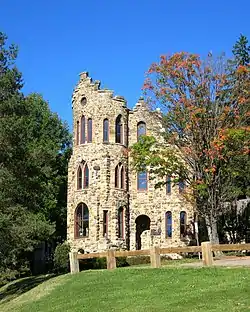Allen Steinheim Museum
The Allen Steinheim Museum is a historic building and former museum located on the campus of Alfred University at Alfred in Allegany County, New York. It is a crenellated stone structure built from 1876 to 1880 to house the "mineral, geological, natural, and man-made curiosities" of Alfred University's second president Jonathan Allen. The building was originally started by Professor Ida Kenyon, who wished to make a private residence that resembled the castles of her native Germany.[2] The building is constructed of over 8,000 rock specimens that were combined to form the walls of the structure and 700 samples of local and foreign wood to combine the internal framework. When operating in the 1930s, it was considered the second oldest college museum in the United States. The Federal Writers Project described the museum as exhibiting a unique collection of "rare shells, mounted birds and animals, Indian artifacts and pioneer agricultural implements, early American pottery, Steigel and Sandwich glass, and the finest workmanship in the ceramic arts".[3] The building ceased being used as a museum in the early 1950s, was used as classroom space, and then fell into disrepair.
Allen Steinheim Museum | |
 Alfred University's Steinheim Building, August 2007 | |
  | |
Map showing location of Allen Stenheim Museum | |
| Location | Alfred University Campus, Alfred, New York |
|---|---|
| Coordinates | 42°15′16″N 77°47′13″W |
| Area | less than one acre |
| Built | 1876-1880 |
| Architect | Allen, Jonathan |
| NRHP reference No. | 73001163[1] |
| Added to NRHP | June 04, 1973 |
After a 1995 renovation and a 1997 dedication, the Steinheim, which is German for "stone house," has since housed the Robert R. McComsey Career Development Center.[4]
In 2008 artist Lenka Clayton devoted time to several projects that sought to call attention to the Steinheim Museum's absent collection.[5] Among these projects were: ""7,000 Stones," that collected a symbolic pile of stones- numbered as if part of a collection- which were then discarded; "Found Instructions 1", that used an inventory sheet of the dying collection- found in the university's Special Collections- to create a modern display; and "Amnesty for the Museum," where she put a call out for the missing artifacts of the collection in order to photograph them in their current environment.
It was listed on the National Register of Historic Places in 1973.[1]
References
- "National Register Information System". National Register of Historic Places. National Park Service. March 13, 2009.
- McFadden, Laurie. "The Steinheim". Archives and Special Collection at Herrick Memorial Library. Alfred University. Archived from the original on 20 December 2013. Retrieved 31 January 2013.
- New York State Historical Association, Federal Writers Project (1940). New York: a Guide to the Empire State. Oxford University Press. p. 662.
- "Cultural Resource Information System (CRIS)". New York State Office of Parks, Recreation and Historic Preservation. Archived from the original (Searchable database) on 2015-07-01. Retrieved 2016-08-01. Note: This includes Steven S. Levy (April 1973). "National Register of Historic Places Registration Form: Steinheim, Alfred, Museum" (PDF). Retrieved 2016-08-01. and Accompanying two photographs
- "Artist offers 'amnesty' on Steinheim artifacts". AU News Press Release. Alfred University. Retrieved 31 January 2013.

